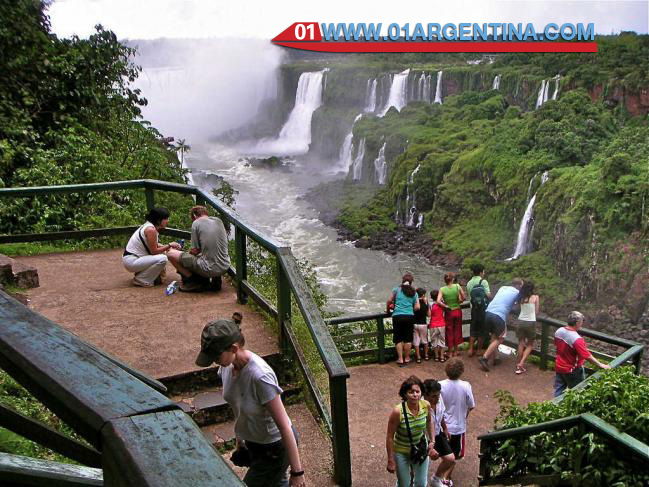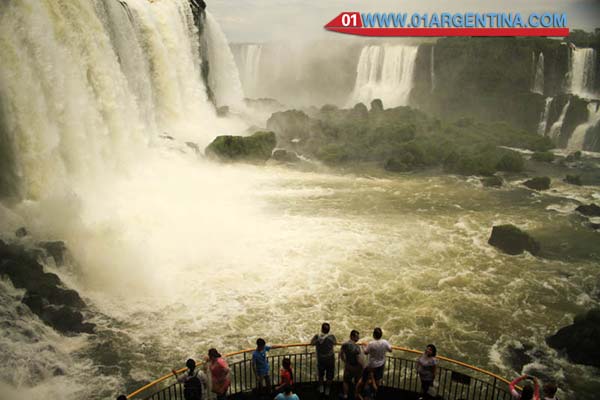The Iguazu waterfalls are made up of 275 waterfalls that fall from the most diverse heights. The highest, 80 meters, is known as the Devil’s Throat.
An incomparable vegetal context frames one of the most opulent natural landscapes in the world: the Iguazu Falls. It consists of more than 2 km of waterfalls that exceed 70 meters in height, a spectacular manifestation of one of the increasingly scarce resources on the planet: water.

The jumps pass along cliffs and islets, spread out in a crescent that forms this geographical feature. The trails can be explored on foot or opt for a picturesque little jungle train, fired by gas, which departs from the Visitor’s Center.
The Falls can be known, basically, through two circuits: a lower one and a higher one. From the bottom one reaches the base of the falls, where the force of the water is transformed into dew or steam that wets the attendees. The experience is unique and it is worth taking the adventure. From this circuit you can also take a boat to San Martín Island.
In the upper circuit, the walk is more sedentary. The panoramic views from the walkways and viewpoints make your stay an unforgettable experience.
The Iguazú National Park is a protected area that preserves one of the most biologically rich sites in Argentina.
This environment is popularly known as Selva Misionera. Here you will find half of the bird species registered in the Argentine territory and the greatest diversity of orchids in the country, to cite just a few examples.
The park was created in 1934 and is one of the first in Argentina. In addition to its scenic beauty, it has high scientific value, since it provides the context to study endangered species, such as the jaguar. The area is an open-air “school” where children and young people can understand the multiple relationships that exist between living things. In addition, the movement generated by tourism is the main driver of economic development in the region.
Puerto Iguazú
This city was a mainstay of the colonization of the Province at the beginning of the 20th century. Today, it is one of the most important towns in Misiones. More than 60,000 inhabitants populate this tourist center, where it is possible to find all kinds of services for the traveler who visits the Falls.
In addition, it is the gateway to the Triple Border with Brazil and Paraguay. The neighboring city of Foz de Iguazú, in Brazil, is reached through the Tancredo Neves international bridge, from which you can cross to the Paraguayan city of Ciudad del Este.

The Aripuca
It is a theme park that aims to make its visitors aware of the effects of indiscriminate felling of trees and caring for the environment, in addition to showing how the missionary jungle was formed at some point.
The aripuca is a trap of Guarani origin that was used to capture animals without hurting them. This agroecotourism project reproduces a giant-sized aripuca to illustrate the richness of the Misiones forest. In this way, people can learn about the characteristics of the logs that make it up, their approximate growth and geographic distribution, as well as their potential and real utility. You also learn about the Guaraní culture through an autochthonous element that was used in their hunting practices.
How to get
La Aripuca is located 4.5 km from Puerto Iguazú, 300 m from National Route 12.
Schedule
Open every day from 9 a.m. to 6 p.m.
(includes gastronomic places).
Approximate duration of the tour: 1 hour
Full moon walks
These fabulous walks invite you to feel the majesty of the Falls at night, lit by the light of the missionary moon. You can also take 4 x 4 vehicle rides, photographic safaris, trekking through the jungle trails, bird watching, flora and fauna, and nautical adventures that bring the visitor closer to the imposing waterfalls.
How to get to Iguazú
By car: along National Route No. 12, which connects it to the South with Puerto Libertad, Eldorado, Posadas and Buenos Aires. To the East, National Route No. 101 leads to the Iguazu Falls. The Tancredo Neves International Bridge connects Puerto Iguazú with Foz de Iguazú (Brazil) and Ciudad del Este (Paraguay).
By plane: the Puerto Iguazú International Airport is one of the busiest in the entire Northeast Region of Argentina. It is accessed by Provincial Route N ° 101.
Or with a complete tour package organized by a local travel agency from Buenos Aires Argentina which will guarantee you the best


